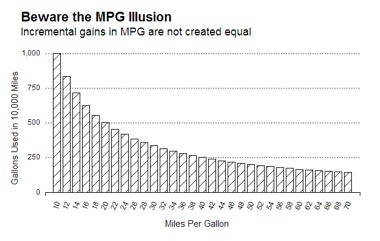Photos of Toyota’s shiny new 2016 Prius leaked onto the Internet this week, supposedly boasting an estimated 60 MPG rating. But should you rush right out to reserve one of your very own? Not so fast. It all depends on the fuel efficiency of whatever you’re driving now.
AU Editor’s Note: This story was put together by our pals at Gizmodo US, but we thought it was interesting enough to share. As such, it’s all about miles per gallon; while we’re used to kilometres per litre (or litres per 100km). You can convert MPG to km/l in this way — 1 MPG is roughly 0.43KM/L. 60 miles per gallon is 3.92l/100km, 50mpg is 4.7l/100km. Here’s a handy converter.
Full disclosure: I drive a 2007 Prius that gets around 50 MPG, and I love my car. But I won’t be running right out to buy the 2016 model just because it offers a 10-point improvement in its MPG rating. If you’re like most people, chances are you assume — as I once did — that there is a linear correlation between miles per gallon and how much gas is used per mile. But that’s not true: the gas used per mile is actually inversely proportional to miles per gallon.
That’s per a 2008 paper in Science by Richard Larrick and Jack Soll of Duke University’s Fuqua School of Business. They call it the “MPG Illusion,” and have argued persuasively that consumers should evaluate the fuel efficiency of their cars not by miles per gallon, but by gallons per mile. In fact, the EPA changed its fuel economy labels to reflect the importance of considering gallons per mile.

Let’s compare two non-hybrid vehicles: one with a perfectly respectable 34 MPG rating, the other with a lower 18 MPG rating. Which will benefit its owner the most by trading it in for a hybrid that gets 50 MPG? If you crunch the numbers, as Larrick and Soll did, you’ll soon find it makes far more sense to replace the gas guzzler than it does to trade in the car that gets 34 MPG. The former will save you 198.4 gallons of gas per 10,000 miles. The latter only saves you 94.1 gallons per 10,000 miles.
Yeah, it’s pretty counterintuitive, but the above graph plotting miles per gallon against gallons used per 10,000 miles clearly shows a downward slope in the data. The higher the MPG, the lower the incremental gains — visual confirmation that gas used per mile is inversely proportional to miles per gallon.
The same principle extends to the 2016 Prius and its marginally higher 60 MPG rating over my ageing 2007 model. You’d think that a 10 MPG increase is the same net gain regardless of whether it’s going from 10 MPG to 20 MPG, or from 50 MPG to 60 MPG. It just isn’t so. Not all 10-MPG incremental improvements are created equal. As Bloomberg News concluded in an article about fuel efficiency last year:
“Once we start reaching ever-higher numbers of MPG efficiency, they matter increasingly less. The big gains are made on inefficient cars. It also means that even 1 MPG gained for an inefficient car is worth a lot more miles per gallon when compared to efficient cars. The different from 10 MPG to 11 MPG is the same as going from 40 MPG to 63 MPG.”
That’s something to bear in mind if you’re contemplating a change in vehicle. This post at Jalopnik notes a waning demand for popular hybrids like the Prius in recent years, in light of falling gas prices:
As cars get more and more fuel efficient, buyers can get their big vehicles and decent gas mileage these days. Not Prius gas mileage, mind you, but in a world of cheap gas and 30 MPG crossovers, the hybrid’s appeal seems a bit more narrow.
Those consumers might just be reacting to market forces — or they might be more savvy than they seem. Gas prices fluctuate. There will be a time when those prices shoot up again, most likely sparking renewed interest in hybrids. Yet even then, it might not be worth trading in your old car for a Prius or other hybrid. I plan on driving my 2007 model into the ground.
[Top image via Jalopnik. Graph from Bloomberg News]
Reference: Larrick, R.P., and Soll, J.B. (2008) “The MPG Illusion,” Science 320: 1593-1594.
